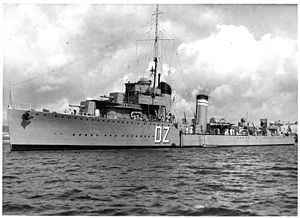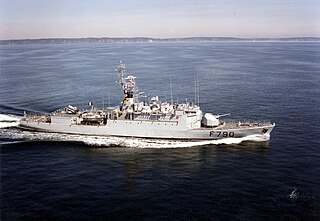
The D'Estienne d'Orves-class avisos, also known as the A69 type avisos, is a class of avisos, comparable in size to a light corvette, mainly designed for coastal anti-submarine defence, but are also available for high sea escort missions. Built on a simple and robust design, they have an economical and reliable propulsion system which allows them to be used for overseas presence missions. They were initially intended for use by the French Navy, but have been acquired by the South African Navy, Argentinian Navy and Turkish Navy.
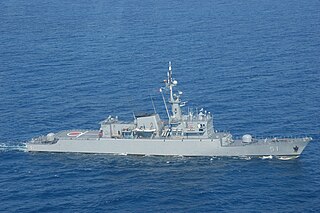
The Almirante Padilla-class frigates is a series of frigates operated by the Colombian Navy. The designation of this class is Type FS 1500 and there are four ships in service. The ships were built by Howaldtswerke-Deutsche Werft (HDW) at Kiel, West Germany in the 1980s, with the first vessel commissioning in 1983 and the last in 1984. The frigates have undergone significant modification over their careers with the 2012 Orion Program Upgrade significantly modernising the vessels. Two similar ships operate as the Kasturi-class corvettes in the Royal Malaysian Navy.

The Almirante Brown class is a class of warships built in Germany for the Argentine Navy. They were commissioned between 1983 and 1984, after the Falklands War. The class comprises four ships; Almirante Brown, La Argentina, Heroína and Sarandí. They are classified as either frigates or destroyers by different publications. The MEKO 360 type warships are based on modular designs which allow quick changes to the vessel's armaments depending on mission requirements. The modular nature of the construction also allows the ships to be modernized or refitted with greater ease. Six vessels were initially ordered, however two ships were cancelled and replaced with orders for MEKO 140 type hulls.

The Claud Jones-class destroyer escorts were four destroyer escorts built for the United States Navy in the late 1950s. These ships were a diesel-powered version of the earlier Dealey class and were designed with the aim of producing a cheaper ship suitable for rapid production in wartime. These ships also had reduced armament and speed compared to their predecessors. They were not seen as effective anti-submarine warfare vessels by the United States Navy and were sold after only 15 years service to the Indonesian Navy.
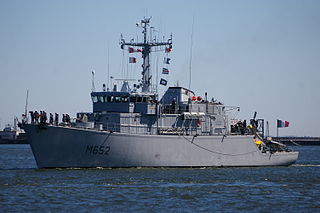
The Tripartite class is a class of minehunters developed from an agreement between the navies of Belgium, France and the Netherlands. A total of 25 ships were constructed for the three navies. The class was constructed in the 1980s–1990s in all three countries, using a mix of minehunting, electrical and propulsion systems from the three member nations. In France, where they are known as the Éridan class they are primarily used as minehunters, but have been used for minesweeping and ammunition transport in Belgium and the Netherlands, where the Tripartites are known as the Alkmaar class.

The MEKO 360 is a class of five ships built in Germany for the Argentine and Nigerian navies. The MEKO 360 was the first version of the MEKO family of vessels built by Blohm und Voss. The type comes in two variants, the MEKO 360H1, comprising one ship, and the MEKO 360H2, comprising four ships. The alternatively classed as frigates and destroyers by different sources. The design is based on the modular concept which allows swapping out different armaments to fit mission requirements and allows easier application of upgrades and refits.

The Hatsuharu-class destroyers were a class of Imperial Japanese Navy destroyers in the service before and during World War II. The final two vessels in the class, completed after modifications to the design, are sometimes considered a separate "Ariake class".

The Marcílio Dias-class destroyers were three destroyers of the Brazilian Navy that served during World War II. They were based on the United States Navy's Mahan class. The Marcílio Dias class were the first warships to be constructed in Brazil of any type. They entered service in 1943 and served on Atlantic convoy duty with the Allies. In July 1944, the three destroyers escorted the Brazilian Expeditionary Force to Italy. Following the end of the war, the destroyers remained in service, undergoing modernisation. Two were discarded in 1966, with the last taken out of service in 1973.

Sánchez Barcáiztegui was a Churruca-class destroyer of the Spanish Republican Navy. She took part in the Spanish Civil War on the side of the government of the Second Spanish Republic.

The Almirante Cervera class were three light cruisers built for the Spanish Navy in the 1920s. The ships were built by Sociedad Española de Construcción Naval in Ferrol which had strong British links and were designed by Sir Philip Watts. The design was based on the British Emerald-class cruiser, but had all boilers grouped together reducing the number of funnels to two. The main armament comprised Vickers pattern 6-inch guns with single mountings in "A" and "Y" positions and twin turrets in "B", "Q" and "X" positions. The programme was initially authorised in 1915 but was delayed by World War I with construction of the first ship starting in 1917.

The Yevgenya class are a series of minesweepers built for the Soviet Navy and export customers between 1967 and 1980. The Soviet designation was Project 1258 Korund.
Project 1252 'Izmrud' were a group of three minesweepers built for the Soviet Navy in the late 1960s. The ships were a glass-reinforced plastic (GRP)-hulled version of the preceding wooden-hulled Vanya class. They were intended to be a prototype of an advanced design, instead the Soviet Navy returned to wooden-hulled minesweeper construction with the following Sonya class. Of the three minesweepers, one was lost in an explosion in 1989 and the fate of the other two is unknown.

The Chidori-class torpedo boat was an Imperial Japanese Navy class of torpedo boats that were built before and served during the Second World War. The design initially proved to have too much armament for its small displacement, and the capsizing of Tomozuru (友鶴) shortly after completion in heavy weather resulted in a scandal which called into question the basic design of many Japanese warships of the time. After extensive modification, the class became satisfactory sea-boats and saw service in the Battle of the Philippines and the Dutch East Indies campaign as escorts and continued in that role for the rest of the war. Three were sunk during the war and the fourth was seized by the British at Hong Kong after the end of the war, where it was scrapped later.

The Mendoza class were a series of three destroyers built in the United Kingdom for the Argentine Navy in the 1920s. They were the first part of the Argentine re-armament programme of the 1920s. Construction began in 1927 and all three were commissioned in 1929. All three destroyers were converted to anti-aircraft escorts in 1958 and remained in service until 1962 when they were discarded.

TCG Sultanhisar was a Demirhisar-class destroyer built for the Turkish Navy during the Second World War. The design of her class was based on the British I class.
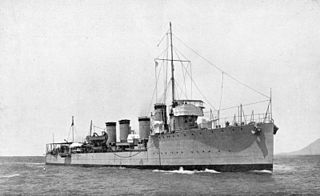
The Alsedo class was a Spanish class of destroyer. Three ships were built, based on a British design, entering service between 1924 and 1925. They all served through and survived the Spanish Civil War, two on the Republican side and one with the Nationalists. The class was retired in 1957–1961.

The Spanish Republican Navy was the naval arm of the Armed Forces of the Second Spanish Republic, the legally established government of Spain between 1931 and 1939.

The EDIC or Engin de débarquement d'infanterie et de chars are large landing craft that operate in the French Navy, Lebanese Navy, Senegalese Navy, and Madagascar Navy. EDICs have the typical landing craft utility design with a bow ramp and have a large aft superstructure compared to the derivative CDIC. The EDIC vessels were constructed in three groups, the first were launched in 1958, the second in 1967–1969 and the third in 1987. A sub class, called the Engin de débarquement ateliers or EDA was constructed between the first and second groups but were fitted out as repair craft. In French service, they predominately were used in the French Pacific territories.

TCG Demirhisar was the name ship of the four her class of destroyers built for the Turkish Navy during the Second World War. The design of her class was based on the British I class.
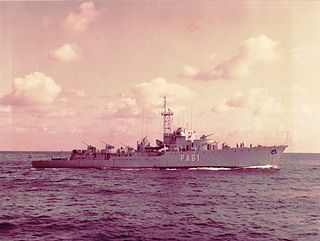
The Atrevida-class was a class of six corvettes built for the Spanish Navy in the 1950s.
